Atlanta echinogyra
Roger R. SeapyIntroduction
Atlanta echinogyra is a small species (to 2.5 mm shell diameter). The spire is moderately low conical, and can be slightly inclined relative to the shell plane. The spire consists of 3-3/4 whorls and is red-violet to red-brown. The spire whorls have incised sutures and bear low spiral ridges on the second through most of the fourth whorls. The outer edge of the third and fourth whorls have a raised ridge (seen best in the larval shell). The keel is moderately elevated with a slightly truncate leading edge. The keel does not insert between the last two shell whorls. The keel base is either clear (North Pacific) or yellow-brown (northern Indian Ocean). Eyes type a. Operculum type c, with a gyre that bears a raised spiral row of strong, tapered spines (hence the specific epithet, echinogyra). Radula type I, with unlimited numbers of tooth rows and lacking sexual dimorphism. Geographic distribution Indo-Pacific. Vertical distribution limited to the upper 100 m in Hawaiian waters.
Diagnosis
- Shell with a maximal diameter of 2.5 mm
- Spire red-violet to red-brown
- Spire of 3-3/4 whorls, with deep sutures and a moderately low conical shape
- Low spiral ridges present on the second through most of the fourth whorls
- Outer edge of third and fourth whorls with a raised ridge
- Keel moderately elevated, with a slightly truncate leading edge
- Keel does not insert between last two whorls
- Keel base clear or yellow-brown
- Eyes type a
- Operculum type c; gyre with a raised spiral row of strong, tapered spines
- Radula type I
Characteristics
- Shell
- Shell small, with a maximal diameter of 2.5 mm
- Shell colorless, except for the keel base (discussed below)
- Shell spire consists of 3-3/4 whorls
- Spire moderately low conical; spire can be slightly to moderately inclined relative to the plane of the post-metamorphic whorls (see tilted views of SEMs below)
- Spire is red-violet to red-brown (see title illustration)
- Sutures of spire whorls deep, enabling easy distinction of the whorls (see second and fourth SEMs below)
- Low spiral ridges increase from two on the second whorl to three on most of the fourth whorl (see second SEM below)
- Keel moderately elevated, with slightly truncate leading edge (clearly illustrated in the photograph by Richter [1972, fig. 5] of the holotype shell with a nearly-intact keel)
- Keel base is either clear (in North Pacific, Hawaiian specimens; Seapy, 1990a; see title illustration) or dark brown to yellow-brown (in Indian Ocean specimens; Richter, 1974)
- Keel does not insert between penultimate and last shell whorls
 Click on an image to view larger version & data in a new window
Click on an image to view larger version & data in a new window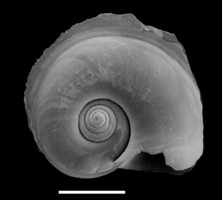
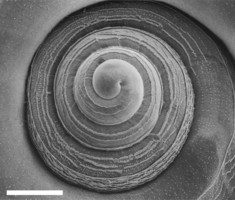
Figure. Scanning electron micrographs of Atlanta echinoygra shell (left) and shell spire (right) viewed from the right side. Scale bars = 0.5 mm and 0.1 mm, respectively. © Roger R. Seapy
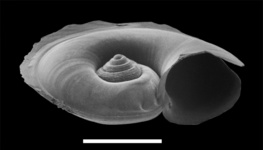
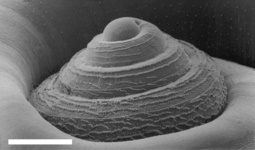
Figure. Scanning electron micrographs of Atlanta echinoygra shell (left) and shell spire (right) viewed from the right side at about a 60° tilt. Scale bars = 0.5 mm and 0.1 mm, respectively. © Roger R. Seapy
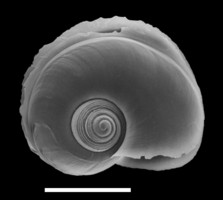
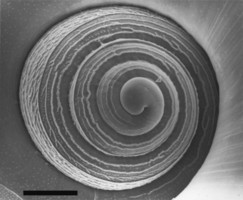
Figure. Scanning electron micrographs of Atlanta echinoygra shell (left) and shell spire (right) viewed from the right side. Scale bars = 0.5 mm and 0.1 mm, respectively. © Roger R. Seapy
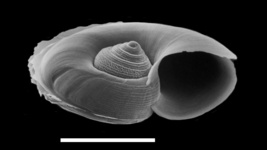
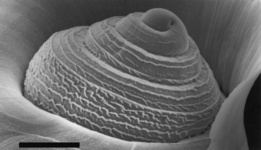
Figure. Scanning electron micrographs of Atlanta echinoygra shell (left) and shell spire (right) viewed from the right side at about a 60° tilt. Scale bars = 0.5 mm and 0.1 mm, respectively. © Roger R. Seapy
- Internal walls of spire whorls intact; not decalcified as in the Atlanta inflata species group
- Larval shell with spiral ridges and raised ridge on the outer margin of the whorls. Complex pattern of primary spiral and secondarily diagonal ridges on lateral sides of the exposed whorls (see second SEM below)
 Click on an image to view larger version & data in a new window
Click on an image to view larger version & data in a new window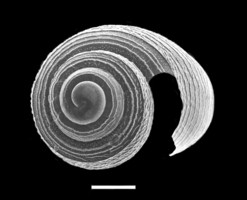
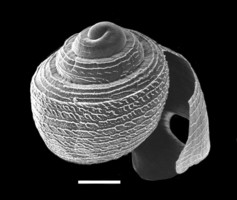
Figure. Larval shell of Atlanta echinogyra viewed from the right side (left) and right side, tilted at about 60° (right). Scale bars = 100 µm. © Roger R. Seapy
- Eyes type a, without a transverse slit in the distal pigmented tissue
- Operculum type c (monogyre)
- Shape of operculum broad, oval
- Opercular gyre with an elevated spiral row of strong spines that taper distally. When mounted on a microscope slide with a cover slip added, the pressure of the cover slip causes the tips of the spines to bend (see second photograph below). Additional photographs of the opercular gyre were included in three papers by Richter (1972, fig. 3; 1974, fig. 5; and, 1987, fig. 42). Drawings of 10 opercula of A. echinogyra (misidentified as A. inflata) were included in a study by Tokioka (1961, figs. 11, 12); four of which are included below from animals of different sizes (shell diameters = 0.6-1.5 mm)
 Click on an image to view larger version & data in a new window
Click on an image to view larger version & data in a new window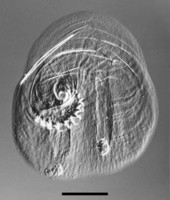
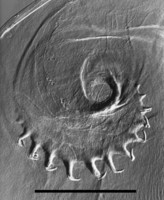
Figure. Operculum from a 1.0 mm Atlanta echinogyra (left) and close-up of gyre region with spiral row of raised, broad spines (right). Scale bars = 100 µm. © Roger R. Seapy
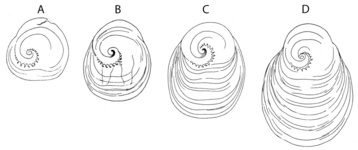
Figure. Sketches of four opercula from Atlanta echinogyra. Shell diameters of specimens from which opercula were removed = 0.6, 1.0, 1.2, and 1.5 mm, respectively. Drawings scanned from Tokioka (1961, fig. 11). © 1961 T. Tokioka
- Radula type I
- Number of tooth rows unlimited
- No sexual dimorphism in radular or tooth size or shape
 Click on an image to view larger version & data in a new window
Click on an image to view larger version & data in a new window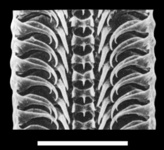
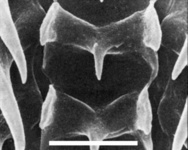
Figure. Radula of Atlanta echinogyra; section of radula with about six tooth rows (left) and close up of two central teeth (right). Images from Richter (1987, figs. 47 and 57), modified by addition of scale bars (= 50 µm and 10 µm, respectively). © 1987 G. Richter
Comments
Atlanta echinogyra was described by G. Richter in 1972 based on specimens collected during the Meteor Expedition to the northern Indian Ocean. Richter named the species after the raised spiral row of spines on the opercular gyre (see second SEM above).
From plankton samples collected in the Indian Ocean (Richter, 1974), Atlanta echinogyra was the fourth most numerous species of heteropod, accounting for 9.1% of the total). In the Pacific Ocean from Australian and Hawaiian waters, however, the species has been recorded as rare or absent. Off northeastern Australia it was uncommon, ranking ninth of nineteen heteropod species and accounting for 1.5% of the total (Seapy et al., 2003). Off Hawaii it was reported (Seapy, 1990a,b and 1980) as either rare or absent. In the first paper it was rare (ranking eleventh of thirteen atlantid species), in the second paper it was absent, while in the third paper it was either absent (fall) or rare (spring; ranking fourteenth of seventeen heteropod species and accounting for 0.09% of the mean nighttime densities).
References
Richter, G. 1972. Zur Kenntnis der Gattung Atlanta (Heteropoda: Atlantidae). Archiv für Molluskenkunde 102(1/3): 85-91.
Richter, G. 1974. Die Heteropoden der "Meteor" Expedition in den Indischen Ozean 1964/65. "Meteor" Forschungs-Ergibnisse Ser. D, No. 17, pp. 55-78.
Richter, G. 1987. Zur Kenntnis der Gattung Atlanta (III), Atlanta inflata, A. helicinoides, A. echinogyra und A. plana (Prosobranchia: Heteropoda). Archiv für Molluskenkunde 117: 177-201.
Seapy, R. R. 1990a. The pelagic family Atlantidae (Gastropoda: Heteropoda) from Hawaiian waters: a taxonomic survey. Malacologia 32: 107-130.
Seapy, R. R. 1990b. Patterns of vertical distribution in epipelagic heteropod molluscs off Hawaii. Marine Ecology Progress Series 60: 235-246.
Seapy, R. R. 2008. Offshore-inshore and vertical distributional patterns of heteropod mollusks off leeward Oahu, Hawaii. Marine Biology 154: 985-995.
Seapy, R. R., C. M. Lalli and F. E. Wells. 2003. Heteropoda from western Australian waters, pp. 513-546. In: F. E. Wells, D. I. Walker and D. S. Jones (eds.), The Marine Flora and Fauna of Dampier, Western Australia. Western Australia Museum, Perth.
Tokioka, T. 1961. The structure of the operculum of the species of Atlantidae (Gastropoda: Heteropoda) as a taxonomic criterion, with records of some pelagic mollusks in the North Pacific. Publications of the Seto Marine Biological Laboratory 9: 267-332.
Title Illustrations

| Scientific Name | Atlanta echinogyra |
|---|---|
| Location | Hawaiian waters |
| Specimen Condition | Live Specimen |
| Sex | Female |
| Life Cycle Stage | adult |
| View | right side |
| Image Use |
 This media file is licensed under the Creative Commons Attribution-NonCommercial License - Version 3.0. This media file is licensed under the Creative Commons Attribution-NonCommercial License - Version 3.0.
|
| Copyright |
©
Roger R. Seapy

|
About This Page
Roger R. Seapy

California State University, Fullerton, California, USA
Correspondence regarding this page should be directed to Roger R. Seapy at
rseapy@fullerton.edu
Page copyright © 2011 Roger R. Seapy
 Page: Tree of Life
Atlanta echinogyra .
Authored by
Roger R. Seapy.
The TEXT of this page is licensed under the
Creative Commons Attribution License - Version 3.0. Note that images and other media
featured on this page are each governed by their own license, and they may or may not be available
for reuse. Click on an image or a media link to access the media data window, which provides the
relevant licensing information. For the general terms and conditions of ToL material reuse and
redistribution, please see the Tree of Life Copyright
Policies.
Page: Tree of Life
Atlanta echinogyra .
Authored by
Roger R. Seapy.
The TEXT of this page is licensed under the
Creative Commons Attribution License - Version 3.0. Note that images and other media
featured on this page are each governed by their own license, and they may or may not be available
for reuse. Click on an image or a media link to access the media data window, which provides the
relevant licensing information. For the general terms and conditions of ToL material reuse and
redistribution, please see the Tree of Life Copyright
Policies.
- First online 28 March 2010
- Content changed 23 July 2011
Citing this page:
Seapy, Roger R. 2011. Atlanta echinogyra . Version 23 July 2011 (under construction). http://tolweb.org/Atlanta_echinogyra/28756/2011.07.23 in The Tree of Life Web Project, http://tolweb.org/




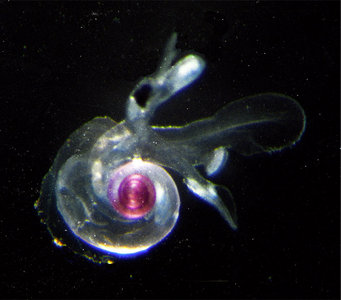
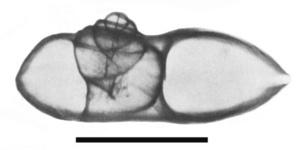
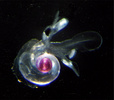


 Go to quick links
Go to quick search
Go to navigation for this section of the ToL site
Go to detailed links for the ToL site
Go to quick links
Go to quick search
Go to navigation for this section of the ToL site
Go to detailed links for the ToL site